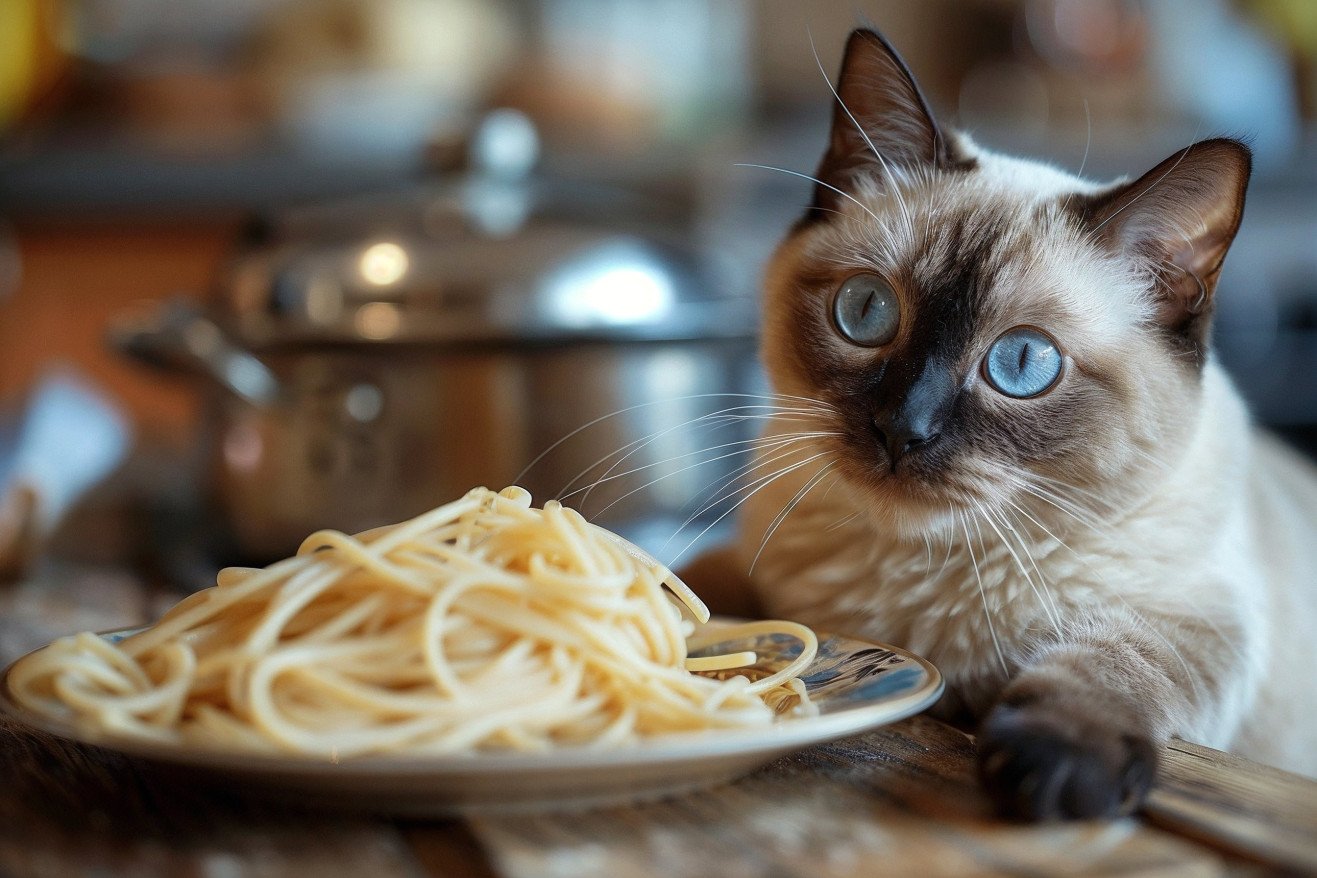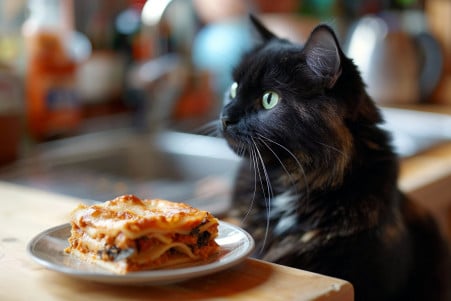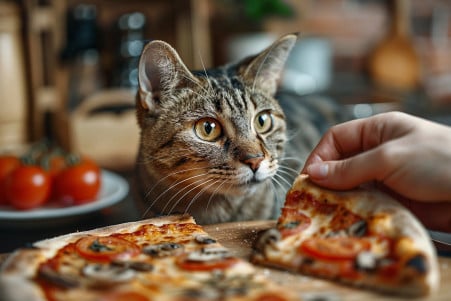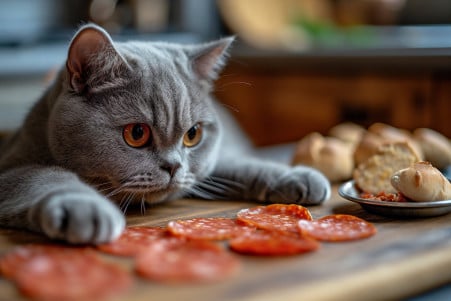Can Cats Eat Pasta? A Guide to Safe Feline Treats
29 February 2024 • Updated 27 February 2024

Pasta is a dietary staple for many people, but is it OK to share this food with your cat? While pasta is not a food that should be part of a cat’s regular diet, cats can have small amounts of plain, cooked pasta as an occasional treat.
That said, pasta does not contain the nutrients that cats need and can contribute to weight gain if consumed too often. It’s also important to note that pasta that contains toxic ingredients like garlic or onions should never be given to cats.
In this deep dive into the complexities of cat nutrition, we will cover research from veterinary science, animal nutrition, and pet health recommendations. This will include research on what cats need in their diets and how certain human foods impact their health.
By the end of this article, you will know what a healthy diet looks like for cats and whether or not pasta can be part of it. You’ll also have the knowledge you need to make sure your cat’s treats are safe.
Can cats eat pasta?
Nutritional Requirements for Your Cat
Cats are obligate carnivores, which means they need nutrients that are found in animal tissues to survive. According to the Cornell University College of Veterinary Medicine, this means that cats need a diet that is high in protein, moderate in fat, and low in carbohydrates. A diet that is rich in protein is important for cats because it provides the essential amino acids and fatty acids that are not found in plant-based materials.
The importance of animal-based proteins in a cat’s diet is highlighted by the fact that cats require taurine and arachidonic acid, both of which are only found in animal tissues. While many commercial cat foods contain carbohydrates, they are not essential to a cat’s diet. In fact, feeding cats a diet that is high in carbohydrates can lead to health problems like obesity and diabetes, according to PMC.
The Association of American Feed Control Officials (AAFCO) has established guidelines to make sure that the cat food that’s available in stores meets the minimum nutritional requirements for cats. These guidelines ensure that cat food contains a complete and balanced profile of essential nutrients, which means that no supplements are needed.
Knowing this information can help cat owners make informed decisions about the treats they feed their cats, including pasta, which is fine in moderation.
Cats’ Highly Specialized Digestive System and Carbohydrate Metabolism
Cats’ highly specialized digestive system is a result of their evolution as obligate carnivores. According to a report from Washington State University, this system includes the mouth, esophagus, stomach, intestines, pancreas, liver, and gallbladder, and has evolved to best process animal-based proteins.
The surgical anatomy outlined in a report from the Public Library of Science further confirms that these adaptations are designed to support a diet that is high in protein and low in carbohydrates.
Cats have some ability to digest carbohydrates, but it’s limited due to low levels of salivary amylase and intestinal brush border disaccharidases compared to other species, according to a report by Myriam Hesta. Cats’ evolutionary adaptations have allowed them to metabolize carbohydrates to some extent, but it’s not their strong suit.
As the article ‘Cats and Carbohydrates: The Carnivore Fantasy?’ from the Public Library of Science notes, a high-carbohydrate diet, like one that includes pasta, can lead to health problems like obesity and diabetes.
Scholarly sources indicate that carbohydrates have a place in cats’ diets, but it’s a limited one. They acknowledge that while cats wouldn’t eat carbohydrates in the wild, they can digest them in small amounts.
However, the potential health problems associated with a high-carbohydrate diet are well-documented, and this makes it clear that pasta should be an occasional indulgence rather than a dietary staple for cats. This is especially true when you consider the ingredients in many pasta dishes, which may include items that are not just non-nutritious but also potentially toxic to cats.
Other Dangers of Feeding Cats Pasta
While a small bite of plain pasta is unlikely to pose a risk to your cat, some of the ingredients commonly found in pasta, like garlic and onions, are toxic to cats. The Merck Veterinary Manual warns that even small amounts of allium vegetables can cause hemolytic anemia in cats, which is a condition where red blood cells are destroyed.
This can lead to symptoms like weakness, rapid breathing, and lethargy, and while these symptoms may not show up for several days, the harm to your cat’s body can be severe, so it’s important to seek veterinary care immediately.
Pasta sauces, many of which contain garlic, onions, or leeks, are therefore especially risky. The PDSA notes that cats that have ingested these ingredients may require treatments like vomiting induction, activated charcoal to absorb the toxins, and even a fluid drip.
To keep your cat safe, make sure to avoid feeding them human foods that may contain toxic ingredients. Always read labels carefully and be especially cautious when it comes to any food that may contain alliums. In general, it’s best to play it safe by keeping pasta and its fixings away from your cat and instead opting for treats that can help support your cat’s health.
Everything in Moderation: The Golden Rule of Cat Treats
Veterinary recommendations, as noted by The Wildest, advise that treats should make up only a small part of a cat’s diet, and ideally no more than 10% of their daily caloric intake. This way, treats won’t take the place of the essential nutrients that cats get from their regular, well-balanced meals. When choosing treats for your pet, it’s important to make sure that they will help fill in the gaps in their diet.
The Association of American Feed Control Officials (AAFCO) stresses that moderation is important to avoid nutrient imbalances and obesity, since pet treats aren’t required to meet the nutritional adequacy of a complete diet. Meanwhile, the ASPCA notes that it’s important to make sure that cats are eating high-quality commercial pet foods that are formulated to meet all of their nutritional needs.
In addition to traditional treats, don’t forget that non-food rewards like playtime, new toys, or a warm place to rest can be just as rewarding to cats. By offering a mix of treats and rewards, you can make sure that your cat’s life is as full as possible while still keeping them healthy and strong.
Always talk to a vet about your cat’s diet to make sure that it’s meeting their needs and taking their lifestyle into account.
Navigating Feline Nutrition: The Final Word on Pasta for Cats
In summary, our exploration of the nutritional needs of cats has shown that while pasta is not toxic to cats, it is not nutritionally beneficial and can even be harmful. Cats are obligate carnivores and require a diet that is high in animal-based protein and low in carbohydrates. Pasta, which is high in carbohydrates and low in protein, does not provide the nutrients that cats need to be healthy.
Our look at the cat digestive system has shown that it is adapted to a diet that is high in animal-based protein and not well-equipped to digest carbohydrates. This means that pasta is not a good choice for cats, especially since high-carb diets can lead to obesity and diabetes. In addition, it’s important to remember that many pasta dishes contain garlic and onions, which are toxic to cats.
As always, the key to feeding cats treats like pasta is moderation. It’s important for pet parents to choose treats, including pasta, that meet cats’ nutritional needs and contribute to their overall health.
In short, while cats can eat small amounts of plain pasta without any ill effects, it should not be a substitute for a healthy, protein-rich diet that meets your cat’s nutritional needs. By making good, safe choices about what to feed our cats, we can help them live long, healthy lives.


